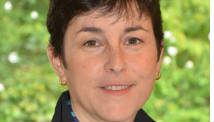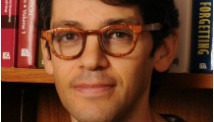Syrians search for survivors and bodies after the Syrian regime attacked the city of Aleppo with missiles on February 23.
STORY HIGHLIGHTS
- Frida Ghitis: We are standing by as Syria rips itself apart, thinking it's not our problem
- Beyond the tragedy in human terms, she says, the war damages global stability
- Ghitis: Syria getting more and more radical, jeopardizing forces of democracy
- Ghitis: Peace counts on moderates, whom we must back with diplomacy, training arms
Editor's note: Frida Ghitis is a world affairs columnist for The Miami Herald and World Politics Review. A former CNN producer and correspondent, she is the author of "The End of Revolution: A Changing World in the Age of Live Television." Follow her on Twitter: @FridaGColumns
(CNN) -- Last week, a huge explosion rocked the Syrian capital of Damascus, killing more than 50 people and injuring hundreds. The victims of the blast in a busy downtown street were mostly civilians, including schoolchildren. Each side in the Syrian civil war blamed the other.
In the northern city of Aleppo, about 58 people -- 36 of them children -- died in a missile attack last week. Washington condemned the regime of Bashar al-Assad; the world looked at the awful images and moved on.
Syria is ripping itself to pieces. The extent of human suffering is beyond comprehension. That alone should be reason enough to encourage a determined effort to bring this conflict to a quick resolution. But if humanitarian reasons were not enough, the international community -- including the U.S. and its allies -- should weigh the potential implications of allowing this calamity to continue.

Frida Ghitis
We've all heard the argument: It's not our problem. We're not the world's policeman. We would only make it worse.
This is not a plea to send American or European troops to fight in this conflict. Nobody wants that.
But before we allow this mostly hands-off approach to continue, we would do well to consider the potential toll of continuing with a failed policy, one that has focused in vain over the past two years searching for a diplomatic solution.
U. S. Secretary of State John Kerry has just announced that the U.S. will provide an additional $60 million in non-lethal assistance to the opposition. He has hinted that President Obama, after rejecting suggestions from the CIA and previous Secretary of State Hillary Clinton to arm Syrian rebels, might be ready to change course. And not a day too soon.
The war is taking longer than anyone expected. The longer it lasts, the more Syria is radicalized and the region is destabilized.
If you think the Syrian war is the concern of Syrians alone, think about other countries that have torn themselves apart over a long time. Consider Lebanon, Afghanistan or Somalia; each with unique circumstances, but with one thing in common: Their wars created enormous suffering at home, and the destructiveness eventually spilled beyond their borders. All of those wars triggered lengthy, costly refugee crises. They all spawned international terrorism and eventually direct international -- including U.S. -- intervention.
The uprising against al-Assad started two years ago in the spirit of what was then referred to -- without a hint of irony -- as the Arab Spring. Young Syrians marched, chanting for freedom and democracy. The ideals of equality, rule of law and human rights wafted in the air.
Al-Assad responded to peaceful protests with gunfire. Syrians started dying by the hundreds each day. Gradually the nonviolent protesters started fighting back. Members of the Syrian army started defecting.
The opposition's Free Syrian Army came together. Factions within the Syrian opposition took up arms and the political contest became a brutal civil war. The death toll has climbed to as many as 90,000, according to Kerry. About 2 million people have left their homes, and the killing continues with no end in sight.
In fairness to Washington, Europe and the rest of the international community, there were never easy choices in this war. Opposition leaders bickered, and their clashing views scared away would-be supporters. Western nations rejected the idea of arming the opposition, saying Syria already has too many weapons. They were also concerned about who would control the weaponry, including an existing arsenal of chemical and biological weapons, after al-Assad's fall.
These are all legitimate concerns. But inaction is producing the worst possible outcome.
The moderates, whose views most closely align with the West, are losing out to the better-armed Islamists and, especially, to the extremists. Moderates are losing the ideological debate and the battle for the future character of a Syria after al-Assad.
Radical Islamist groups have taken the lead. Young people are losing faith in moderation, lured by disciplined, devout extremists. Reporters on the ground have seen young democracy advocates turn into fervent supporters of dangerous groups such as the Nusra Front, which has scored impressive victories.
The U.S. State Department recently listed the Nusra Front, which has close ties to al Qaeda in Iraq and a strong anti-Western ideology, as a terrorist organization.
Meantime, countries bordering Syria are experiencing repercussions. And these are likely to become more dangerous.
Jordan, an important American ally, is struggling with a flood of refugees, as many as 10,000 each week since the start of the year. The government estimates 380,000 Syrians are in Jordan, a country whose government is under pressure from its own restive population and still dealing with huge refugee populations from other wars.
Turkey is also burdened with hundreds of thousands of refugees and occasional Syrian fire. Israel has warned about chemical weapons transfers from al-Assad to Hezbollah in Lebanon and may have already fired on a Syrian convoy attempting the move.
Lebanon, always perched precariously on the edge of crisis, lives with growing fears that Syria's war will enter its borders. Despite denials, there is evidence that Lebanon's Hezbollah, a close ally of al-Assad and of Iran, has joined the fighting on the side of the Syrian president. The Free Syrian Army has threatened to attack Hezbollah in Lebanon if it doesn't leave Syria.
The possible outcomes in Syria include the emergence of a failed state, stirring unrest throughout the region. If al-Assad wins, Syria will become an even more repressive country.
Al-Assad's survival would fortify Iran and Hezbollah and other anti-Western forces. If the extremists inside the opposition win, Syria could see factional fighting for many years, followed by anti-democratic, anti-Western policies.
The only good outcome is victory for the opposition's moderate forces. They may not be easy to identify with complete certainty. But to the extent that it is possible, these forces need Western support.
They need training, funding, careful arming and strong political and diplomatic backing. The people of Syria should know that support for human rights, democracy and pluralism will lead toward a peaceful, prosperous future.
Democratic nations should not avert their eyes from the killings in Syria which are, after all, a warning to the world.
Follow us on Twitter @CNNOpinion.
Join us on Facebook/CNNOpinion.
The opinions expressed in this commentary are solely those of Frida Ghitis.

